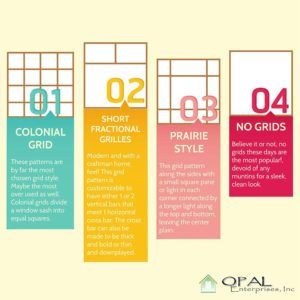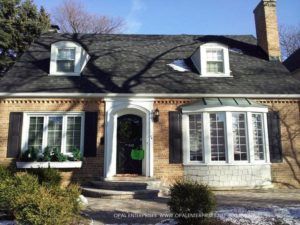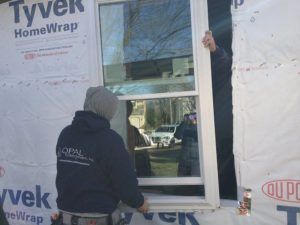Your home’s windows have served you well for many years; though, lately you’ve noticed they’re looking dingy and showing some wear and tear. Plus, your house is constantly drafty, and your energy bills continue to climb month after month. These are signs it’s time for new windows.
Window replacement in Downers Grove come in an overwhelming array of options, and choosing them is often a challenge. The decision-making process is different for every homeowner, and your final choice will largely depend on your personal preference and budget. Here are factors to consider when selecting new windows for your home.
How Do I Know It’s Time to Replace My Windows?
Windows don’t wear out overnight. Instead, they often age gradually; squeaks, sticking, and other problems increase until they eventually become impossible to ignore. You’ll know it’s time to choose replacement windows if:
- They allow too much heat to transfer through the glass, frames, or sashes: Cheaply constructed windows or those that don’t insulate against outside temperatures are costing you money every month in the energy they waste.
- They are letting in moisture: If your panes are cracked, or you notice water infiltration or condensation, your windows are not sealing correctly. You’ll want to replace them sooner rather than later to guard against water damage.
- You struggle to open and close them: As windows age, it can become more difficult to slide them open and closed. This could be due to damage, rotting frames, or wood swelling and contraction, causing them to stick in the frames.
What Should I Consider When Replacing Windows?
When weighing your new window options, there is one primary calculation that you should always consider: the window’s cost versus its potential benefits. Which windows will give you the most significant return on appearance, comfort, energy savings, and added property value without exceeding your home improvement budget?
Top-of-the-line windows with maximum energy efficiency features may sound like a good idea, but they may not save you enough to warrant their higher cost. Similarly, custom-designed windows with lots of added aesthetic details might not fall in your price range.
On the other hand, opting for basic windows at a low price point will save your bottom-line upfront, but down the road may cost more. Low-efficiency or lower quality windows will not add as much value to your home, and they could cost you significantly in higher heating and cooling costs.
When considering Plainfield replacement windows for your home in Plainfield and other areas in Illinois, decide on the attributes you can’t live without and then strike a balance between cost and benefits.
Understanding the Anatomy of a Window
As you begin shopping for new windows, you’ll likely come across terms and phrases that are unfamiliar to you. To ensure you’re making the best window-buying decision you can make, you should understand these common window parts and their definitions:
- Frame: This is the fixed structural support around the window itself. There are generally four sides to a window frame—the head jamb (top), two side jambs, and the sill or stool (bottom).
- Casing: The casing is the trim that goes around the frame.
- Sash: A sash is the window framework that holds the glass in place. Sashes can sometimes move up and down to open the window, or they may tilt in for easier cleaning.
- Cladding: Cladding is the layer of aluminum, fiberglass, or vinyl sometimes found on the exterior side of a window sash. Cladding serves as a shield to protect the window’s wooden or composite core against weather damage.
- Pane: This is the glass part of the window. Single-pane options come with one pane of glass, while others are offered in double- or triple-pane glass to reduce heat transfer and noise.
- Grille: A grille is a square or diamond decorative pattern laid over a single sheet of glass, dividing it up into smaller panes. Types of grilles include removable wood grills, grilles in the airspace (GIA), true divided lites (TDL), and simulated divided lites (SDL).
What Type of Window Is Most Energy-Efficient?
Energy efficiency is a major consideration for many homeowners when selecting new windows. This factor is especially crucial in locations with extreme temperatures like we experience in the Chicago area. When the temperatures drop, you’ll want windows that can efficiently seal in the heat and keep out the cold.
Energy-efficient windows make your home more comfortable for you and your family. They also prevent your heating and air conditioning systems from working too hard to maintain an ideal temperature.
Generally, the more energy-efficient the window, the higher its cost. Variables that increase its energy efficiency include:
- U-factor: A window’s U-factor or U-value measures how well it can prevent heat from traveling from one side to the other. It is expressed as a number ranging from 0.20 to 1.2, with lower numbers translating to higher efficiency.
- Insulated glass: Double- or triple-pane windows have a space between the panes that are sealed and filled with argon or another gas. This gas forms an added layer of insulation to help maintain constant temperatures.
- Solar heat gain coefficient: This number between zero and one measures how much heat the sun can get through a window. A high number means it lets more heat through, which is good in colder climates, while a low number is better in warmer locations.
- Low-E coating: Manufacturers can apply a transparent glaze to glass that reflects heat while allowing light to pass through. This glaze is often put on the inside of the window in cool climates to keep heat in. It’s added to the exterior of the window in warmer climates to keep heat out.
Choosing the Material for Your New Windows
Window frames and sashes come in a wide variety of materials, with each alternative having pros and cons. When selecting the material for your windows, you will want to consider how they’ll look, how well they’ll function, and how much they’ll cost.
Some of the most popular window materials you can choose from are:
- Wood: Wood windows have a highly customizable appearance, with various wood species and colors available that can be matched to any home’s aesthetic. Wood is often valued for its beauty and energy efficiency, though it may take more work to maintain.
- Vinyl: Vinyl is a synthetic polymer that provides homeowners with a durable and lower-cost window option. It requires less maintenance than wood, though it has fewer color choices.
- Aluminum: Aluminum is a lightweight yet strong metal ideal for humid areas or those prone to severe storms and wind. However, aluminum does not insulate well against heat transfer.
- Fiberglass: Made from a mix of polyester resins and glass fibers, fiberglass windows are highly energy-efficient and sturdy. On the negative side, they tend to be more expensive than windows made from other materials.
- Composite: Plastic resins and wood pulp are combined to make composite windows. They have the beauty of wood without its high maintenance requirements. And they are often made using environmentally friendly recycled materials.
- Wood-clad: Wood windows with vinyl or aluminum exteriors are energy-efficient, attractive, and low maintenance. However, they can be prone to leaking and subsequent wood rot if not installed correctly.
Choosing the Right Glass for Your Replacement Windows
Your glass selection will primarily be based on how energy efficient you want your new windows to be. However, different types of glass sometimes have unique designs or functional aspects, so aesthetics can also play a role in these decisions.
Some glass options to consider for your replacement windows in St. Charles and other service areas include:
- Obscured glass: This is non-transparent glass, which means it is opaque rather than transparent and cannot be seen through. The opacity is often created through etchings, a frosted finish, or a special coating that allows light to pass through. Obscured glass is a popular option for areas where privacy is a concern, such as around front doors or in bathrooms.
- Double- or triple-paned: Triple-paned windows will be somewhat more energy-efficient than double-paned, but this will not always result in significant cost savings on your energy bills. However, it may be a worthwhile investment in areas where winters are frigid.
- Argon or krypton insulation: The space between the panes can be filled with either argon gas, which is more cost-effective, or krypton gas, which uses less space. Argon gas fills are usually utilized in double-paned windows, while the smaller gaps found in triple-paned windows often require the use of krypton gas.
- UV protection: Manufacturers sometimes offer an ultraviolet (UV) light repelling film for their glass. This can protect your belongings from the fading effects of the sun and keep your home cooler, especially when used on south-facing windows.
Choosing the Optimal Window Style
When selecting your replacement window styles, keep in mind your home’s overall architectural style and the unique characteristics of each window’s size and location.
Choosing a new window that is similar to the one it is replacing is often the most cost-effective option. However, you might take this opportunity to make a change. For example, the installers could reframe your wall opening to allow for a larger window, move it to a new location, or add an arch or transom.
Some common types of windows available for you to choose from include:
- Single-hung: A stationary sash is positioned on top, and a moveable lower sash slides up and down to open and close the window.
- Double-hung: In double-hung windows, both the upper and lower sashes slide to open, allowing for better airflow.
- Casement: The sash of a casement window is hinged on the side, and it opens by swinging outward. These are excellent choices for windy locations since the wind can exert pressure on the closed window and reinforce its seal against the elements.
- Awning: Using a hinge on top instead of on the side, awning windows open by swinging up and out where they are propped open like an awning over your window.
- Garden: Garden windows are boxed projections with glass panes all around, usually installed on a south-facing wall. This provides ample sunlight to houseplants and other decorative displays on the garden window shelves.
- Picture: Picture windows are large windows positioned on the front of a home, providing an unobstructed view of the outside. In most cases, picture windows cannot be opened.
- Arched: Arched windows have a curved half-circle-shaped pane placed above a traditional rectangle window. This adds architectural interest, softens the sharp lines and angles in a room, and allows more sunlight into your home.
- Bay: Bay windows are three or more panes joined together in a room that juts out from the main space to form a bay.
- Bow: A bow window is like a bay window, but more panes are joined together to form a curved arch rather than an angled design.
- Skylight: A window installed in the ceiling to bring in more natural light. Skylights can also often be opened to allow for increased airflow in a room.
Choosing a Window Installation Company
No matter what material, glass options, or style you choose, even the highest-quality window on the market won’t be able to do its job if an installer puts it in incorrectly. Installation is not an area where you want to cut corners.
At Opal Exteriors, we’ve been remodeling homes for satisfied customers in the Chicagoland area since 2003. Our window installers are thoroughly trained and experienced with all types of windows, and we offer a lifetime labor warranty on every window we install!
Discover the Opal difference today by scheduling your free in-home consultation. You can reach us by phone or via our convenient online contact form.





